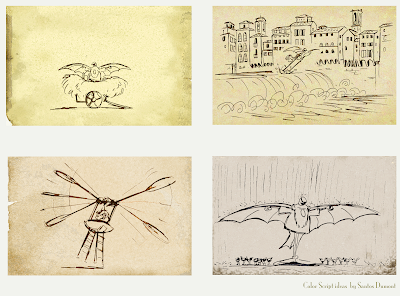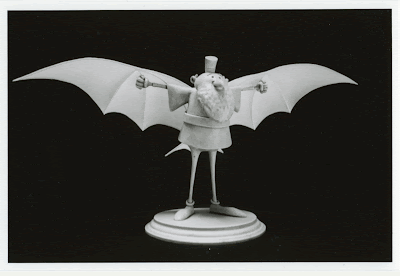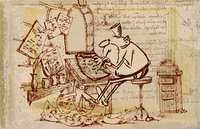10 things I've learned in making a short film: # 2
2) Have a plan
 Part of the color script. The images were taken from the storyboards.
Part of the color script. The images were taken from the storyboards.
I can't stress this enough. You have to have a plan for your film. A blueprint. It seems kind of ridiculous to me to think people wouldn't but they don't. Sometimes they think they do and then it goes out the window when the first difficulty or new idea comes along. Plan the project from preliminary drawings to storyboarding to storyreel. Have your camera moves, staging, acting as thought out as possible before you begin animation. It will save you so much time, money and headache down the line. It provides you with a piece of film to show potential help and even investors. You should even use it to solicit feed back. This is very important and you shouldn't be afraid at this stage to get some critique. Show people who you respect their opinion and even show some strangers. Show your mom but she doesn't count. Be careful though, too much input can take the wind out of your sails. If someone doesn't like something always ask them for a reason. You want constructive criticism. Don't get upset, just take it in. Let the notes percolate for a few days, don't react instantly negatively or positively. Things you initially didn't agree with you might like after a few days stewing on them and ideas you initially loved you'll find don't work. Remember, you are the filmmaker. Take strength in that you have the final say. I showed the short to a couple of the big shot directors at work. They had a few notes ( they can't help themselves) but their ideas were just different. You have to watch out for the make it an elephant not a pachyderm suggestions. They didn't make the short better and I was struck by an empowering feeling: where normally I would have to execute their note this was my film and I did not have to. It was my choice.
 The Leo maquette, sculpted by Jerome Ranft. The wings fabricated by Ron Smith. These were given to the animators to help with turning the character.
The Leo maquette, sculpted by Jerome Ranft. The wings fabricated by Ron Smith. These were given to the animators to help with turning the character.
After planning in terms of the storyreel (blueprint) then plan the rest of the film. Organize it like a real production. It actually is and think of it in that way. I made model packets for the animators, reference reels and exposer sheets. I even made maquettes for them. The film was broken up into 60 scenes (shots) and those were grouped into 13 sequences based on location and story point. Each scene was made into a packet with exposer sheet, character layout drawings, a rough BG (if there was one). I calculated how much animation paper we would need and bought it all at once ( I am on the last box now). Files on the computer are organized by sequence and scenes. There are a lot of little things and organization and planning are paramount to keeping your sanity, saving money and actually getting the thing done.
Tomorrow:
3) Goals Goals Goals.
Without deadlines you will make the film forever.
 Part of the color script. The images were taken from the storyboards.
Part of the color script. The images were taken from the storyboards. I can't stress this enough. You have to have a plan for your film. A blueprint. It seems kind of ridiculous to me to think people wouldn't but they don't. Sometimes they think they do and then it goes out the window when the first difficulty or new idea comes along. Plan the project from preliminary drawings to storyboarding to storyreel. Have your camera moves, staging, acting as thought out as possible before you begin animation. It will save you so much time, money and headache down the line. It provides you with a piece of film to show potential help and even investors. You should even use it to solicit feed back. This is very important and you shouldn't be afraid at this stage to get some critique. Show people who you respect their opinion and even show some strangers. Show your mom but she doesn't count. Be careful though, too much input can take the wind out of your sails. If someone doesn't like something always ask them for a reason. You want constructive criticism. Don't get upset, just take it in. Let the notes percolate for a few days, don't react instantly negatively or positively. Things you initially didn't agree with you might like after a few days stewing on them and ideas you initially loved you'll find don't work. Remember, you are the filmmaker. Take strength in that you have the final say. I showed the short to a couple of the big shot directors at work. They had a few notes ( they can't help themselves) but their ideas were just different. You have to watch out for the make it an elephant not a pachyderm suggestions. They didn't make the short better and I was struck by an empowering feeling: where normally I would have to execute their note this was my film and I did not have to. It was my choice.
 The Leo maquette, sculpted by Jerome Ranft. The wings fabricated by Ron Smith. These were given to the animators to help with turning the character.
The Leo maquette, sculpted by Jerome Ranft. The wings fabricated by Ron Smith. These were given to the animators to help with turning the character.After planning in terms of the storyreel (blueprint) then plan the rest of the film. Organize it like a real production. It actually is and think of it in that way. I made model packets for the animators, reference reels and exposer sheets. I even made maquettes for them. The film was broken up into 60 scenes (shots) and those were grouped into 13 sequences based on location and story point. Each scene was made into a packet with exposer sheet, character layout drawings, a rough BG (if there was one). I calculated how much animation paper we would need and bought it all at once ( I am on the last box now). Files on the computer are organized by sequence and scenes. There are a lot of little things and organization and planning are paramount to keeping your sanity, saving money and actually getting the thing done.
Tomorrow:
3) Goals Goals Goals.
Without deadlines you will make the film forever.







4 Comments:
These posts couldn't have come at a better time! I'll turn my friends over here too. We're all about to start our first-year films, so this is invaluable stuff!
amelia
great! pass it on. good luck and feel free to ask questions.
jim
Great stuff im passing this on as i write. Thanks again
Ben K - Thanks for checking in. I hope it helps.
Post a Comment
<< Home